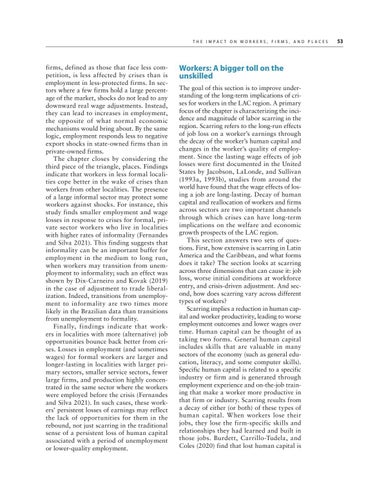T h e I m p ac t o n W o r k e r s , F i r m s , a n d P l ac e s
firms, defined as those that face less competition, is less affected by crises than is employment in less-protected firms. In sectors where a few firms hold a large percentage of the market, shocks do not lead to any downward real wage adjustments. Instead, they can lead to increases in employment, the opposite of what normal economic mechanisms would bring about. By the same logic, employment responds less to negative export shocks in state-owned firms than in private-owned firms. The chapter closes by considering the third piece of the triangle, places. Findings indicate that workers in less formal localities cope better in the wake of crises than workers from other localities. The presence of a large informal sector may protect some workers against shocks. For instance, this study finds smaller employment and wage losses in response to crises for formal, private sector workers who live in localities with higher rates of informality (Fernandes and Silva 2021). This finding suggests that informality can be an important buffer for employment in the medium to long run, when workers may transition from unemployment to informality; such an effect was shown by Dix-Carneiro and Kovak (2019) in the case of adjustment to trade liberalization. Indeed, transitions from unemployment to informality are two times more likely in the Brazilian data than transitions from unemployment to formality. Finally, findings indicate that workers in localities with more (alternative) job opportunities bounce back better from crises. Losses in employment (and sometimes wages) for formal workers are larger and longer-lasting in localities with larger primary sectors, smaller service sectors, fewer large firms, and production highly concentrated in the same sector where the workers were employed before the crisis (Fernandes and Silva 2021). In such cases, these workers’ persistent losses of earnings may reflect the lack of opportunities for them in the rebound, not just scarring in the traditional sense of a persistent loss of human capital associated with a period of unemployment or lower-quality employment.
Workers: A bigger toll on the unskilled The goal of this section is to improve understanding of the long-term implications of crises for workers in the LAC region. A primary focus of the chapter is characterizing the incidence and magnitude of labor scarring in the region. Scarring refers to the long-run effects of job loss on a worker’s earnings through the decay of the worker’s human capital and changes in the worker’s quality of employment. Since the lasting wage effects of job losses were first documented in the United States by Jacobson, LaLonde, and Sullivan (1993a, 1993b), studies from around the world have found that the wage effects of losing a job are long-lasting. Decay of human capital and reallocation of workers and firms across sectors are two important channels through which crises can have long-term implications on the welfare and economic growth prospects of the LAC region. This section answers two sets of questions. First, how extensive is scarring in Latin America and the Caribbean, and what forms does it take? The section looks at scarring across three dimensions that can cause it: job loss, worse initial conditions at workforce entry, and crisis-driven adjustment. And second, how does scarring vary across different types of workers? Scarring implies a reduction in human capital and worker productivity, leading to worse employment outcomes and lower wages over time. Human capital can be thought of as taking two forms. General human capital includes skills that are valuable in many sectors of the economy (such as general education, literacy, and some computer skills). Specific human capital is related to a specific industry or firm and is generated through employment experience and on-the-job training that make a worker more productive in that firm or industry. Scarring results from a decay of either (or both) of these types of human capital. When workers lose their jobs, they lose the firm-specific skills and relationships they had learned and built in those jobs. Burdett, Carrillo-Tudela, and Coles (2020) find that lost human capital is
53

